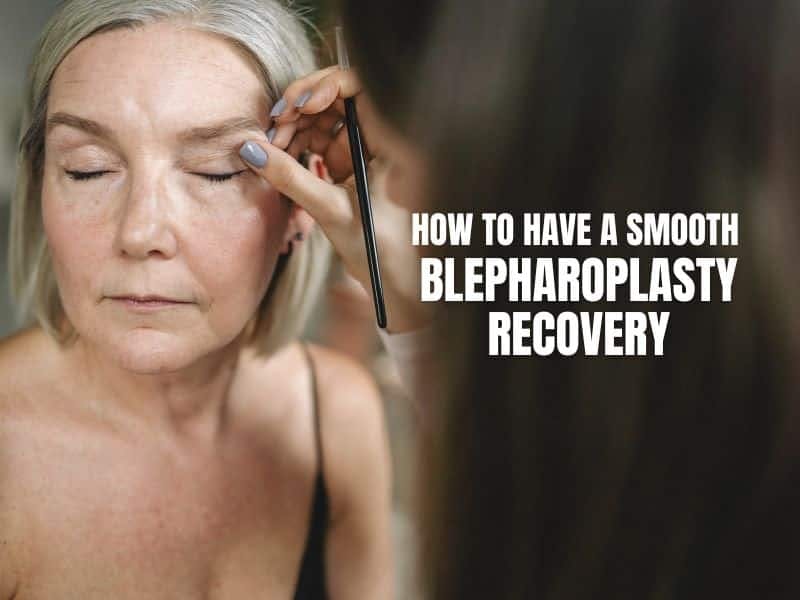
Because eyelid surgery is such a well-established and routinely successful plastic surgery, blepharoplasty recovery is typically well-tolerated by patients.
This is an outpatient procedure, which means that the patient can return home on the same day as their surgery. While some soreness is to be expected over the first few days of upper or lower blepharoplasty recovery, this typically doesn’t last long, and pain medication will be prescribed. Bruising and swelling after eyelid surgery is also normal.
Naturally, every patient will receive a comprehensive list of post operative care instructions from their plastic surgeon following surgery. These must be followed closely. In addition to these basic instructions, we have also assembled the following tips to further assist patients in ensuring a smooth recovery and excellent results.
But first: What is eyelid surgery?
Eyelid Surgery Overview
Eyelid surgery, also known as blepharoplasty or eyelid lift surgery, is a plastic surgery procedure that reduces the amount of excess skin, fat, and loose muscle around the eyes. The goal is to open up the eyes more, giving the patient a wider awake and more alert and youthful look, and sometimes — in the case of upper eyelid surgery — to also reduce vision obstruction.
There are two types of eyelid surgery: upper eyelid surgery (upper blepharoplasty) and lower eyelid surgery (lower blepharoplasty).
Upper Eyelid Surgery
Typically with an upper eyelid lift, a small incision is made within the upper eyelid crease. Then, the underlying muscles of the upper eyelids are manipulated so that they are tighter and smoother, and excess fat and excess skin is removed. The surgical procedure will lift the upper eyelids slightly to improve the vision of the patient and help them to appear more youthful and more awake.
Lower Eyelid Surgery
With a lower eyelid lift, an incision is usually made just below the lower lash line (although it can also be made within the inside of the lower eyelid sometimes). From there, the underlying muscles are manipulated to smooth out the under eye area, and any excess fat and excess skin is carefully removed.
Tips for Ensuring a Successful Blepharoplasty Recovery Time
In order to have a successful healing process after surgery, in addition to the self care instructions you receive from your plastic surgeon, use the following tips.
Learn how to take it easy.
Many patients want to jump back into their normal routines right after surgery, but this should be avoided. Learn how to relax and take it easy. Invite a friend over for some light chitchat, put on a movie, listen to a podcast, or take a nap in the middle of the day. These are all good things for your recovery.
Ease into movement to increase blood flow.
While intensive exercise is out of the question for a few weeks, you can take short walks to help increase blood flow and improve circulation. Following surgery, it’s important to stay mobile as it will help you avoid blood clots.
Don’t hesitate to take your prescribed pain medication.
During the wound healing process, it’s common to have some pain. You won’t win any kind of award for enduring this pain without taking pain medication. Simply follow your surgeon’s directions closely, and use the pain medication to increase your comfort until you don’t need it anymore.
Consider cold compresses as a way to increase comfort.
Some patients may also be able to use cold compresses to reduce pain, increase comfort, and minimize swelling. Talk to your Blepharoplasty Surgeon about this option.
Protect your eyes, especially for the first few weeks.
You may have watery eyes, double vision, blurry vision, or sensitivity to light directly following blepharoplasty surgery. For this reason, be sure to wear dark sunglasses outside, avoid going in direct sunlight, and if you regularly wear contact lenses, wear glasses instead for a while.
Get a good night’s sleep with proper positioning.
Both upper and lower blepharoplasty recovery require you to get plenty of rest and sleep. Prioritize sleep every night by going to bed early, creating a comfortable and dark sleeping space, sleeping at an incline to minimize residual swelling, and staying on your back because rolling over to your side or stomach could hinder your results.
FAQ: Eyelid Surgery & the Recovery Process
How much is eyelid surgery?
Eyelid surgery prices vary based on your geographic location, who your surgeon is, and what type of surgery you have. Patients often want to know about cost, but you really need to book a consultation to get an accurate estimate.
So, will insurance pay for eyelid surgery?
Sometimes — if you need this surgery to improve your vision. All insurance providers are different, however, so you’ll need to contact your health insurance company directly to learn more about your plan and what it offers.
What will my eyelids look like at different stages of blepharoplasty recovery?
At first, your lids will be swollen, sore, and bruised. Over time, your normal skin color will return, swelling will reduce, and you’ll feel less pain. Incision lines will flatten and lighten, and your eyes will start to look normal again.
Patients can often look up “upper blepharoplasty recovery photos day by day” or “day by day one week lower blepharoplasty recovery photos” if they want to see discrete examples of before and after eyelid surgery progress following surgery.
Please Contact Us to Book a Consultation
The healing process after eyelid surgery can go quite smoothly when patients follow their surgeons’ directions carefully and go the extra mile to ensure a safe recovery and great results.
If you have any further questions about eyelid surgery recovery or if you’d like to find out if you’re a good candidate for this cosmetic surgery procedure, please call our office today. Board certified plastic surgeon Dr. Charles Galanis would be happy to meet with you in person to discuss your blepharoplasty surgery in more detail and hear about your goals.


